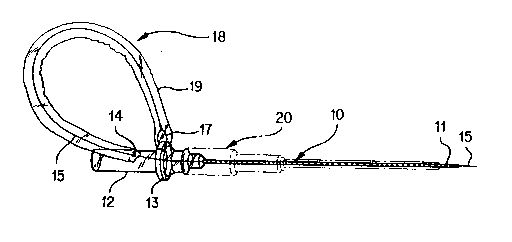Some of the information on this Web page has been provided by external sources. The Government of Canada is not responsible for the accuracy, reliability or currency of the information supplied by external sources. Users wishing to rely upon this information should consult directly with the source of the information. Content provided by external sources is not subject to official languages, privacy and accessibility requirements.
Any discrepancies in the text and image of the Claims and Abstract are due to differing posting times. Text of the Claims and Abstract are posted:
| (12) Patent Application: | (11) CA 2122485 |
|---|---|
| (54) English Title: | ARTERIAL CATHETER |
| (54) French Title: | CATHETER ARTERIEL |
| Status: | Deemed Abandoned and Beyond the Period of Reinstatement - Pending Response to Notice of Disregarded Communication |
| (51) International Patent Classification (IPC): |
|
|---|---|
| (72) Inventors : |
|
| (73) Owners : |
|
| (71) Applicants : |
|
| (74) Agent: | BORDEN LADNER GERVAIS LLP |
| (74) Associate agent: | |
| (45) Issued: | |
| (86) PCT Filing Date: | 1992-10-20 |
| (87) Open to Public Inspection: | 1993-05-13 |
| Examination requested: | 1996-04-12 |
| Availability of licence: | N/A |
| Dedicated to the Public: | N/A |
| (25) Language of filing: | English |
| Patent Cooperation Treaty (PCT): | Yes |
|---|---|
| (86) PCT Filing Number: | PCT/US1992/008939 |
| (87) International Publication Number: | WO 1993008853 |
| (85) National Entry: | 1994-04-28 |
| (30) Application Priority Data: | ||||||
|---|---|---|---|---|---|---|
|
2122485 9308853 PCTABS00021
A catheter system for percutaneous insertion into the lumen of a
vessel which includes a hollow introducer needle (10) coaxially
mounted within the catheter (20). Mounted with the introducer
needle (10) is a guide wire (15) which is attached to the proximal
end (11) of the needle (10) and formed in the shape of a loop (18)
of a length sufficient to provide the necessary amount of wire
(15) to guide the catheter (20) within the lumen. The catheter (20)
has a notched tip (23) to help maintain the tip (22) in the
vessel lumen during guide wire (15) placement and to inhibit passing
through the opposite wall of the vessel lumen during insertion of
the device.
Note: Claims are shown in the official language in which they were submitted.
Note: Descriptions are shown in the official language in which they were submitted.

2024-08-01:As part of the Next Generation Patents (NGP) transition, the Canadian Patents Database (CPD) now contains a more detailed Event History, which replicates the Event Log of our new back-office solution.
Please note that "Inactive:" events refers to events no longer in use in our new back-office solution.
For a clearer understanding of the status of the application/patent presented on this page, the site Disclaimer , as well as the definitions for Patent , Event History , Maintenance Fee and Payment History should be consulted.
| Description | Date |
|---|---|
| Inactive: IPC from MCD | 2006-03-11 |
| Application Not Reinstated by Deadline | 2000-07-24 |
| Inactive: Dead - Final fee not paid | 2000-07-24 |
| Deemed Abandoned - Failure to Respond to Maintenance Fee Notice | 1999-10-20 |
| Deemed Abandoned - Conditions for Grant Determined Not Compliant | 1999-07-22 |
| Notice of Allowance is Issued | 1999-01-22 |
| Letter Sent | 1999-01-22 |
| Notice of Allowance is Issued | 1999-01-22 |
| Amendment Received - Voluntary Amendment | 1999-01-14 |
| Inactive: Approved for allowance (AFA) | 1999-01-08 |
| Amendment Received - Voluntary Amendment | 1998-10-21 |
| Inactive: S.30(2) Rules - Examiner requisition | 1998-07-21 |
| Inactive: Application prosecuted on TS as of Log entry date | 1998-04-22 |
| Inactive: Status info is complete as of Log entry date | 1998-04-22 |
| All Requirements for Examination Determined Compliant | 1996-04-12 |
| Request for Examination Requirements Determined Compliant | 1996-04-12 |
| Application Published (Open to Public Inspection) | 1993-05-13 |
| Abandonment Date | Reason | Reinstatement Date |
|---|---|---|
| 1999-10-20 | ||
| 1999-07-22 |
The last payment was received on 1998-09-21
Note : If the full payment has not been received on or before the date indicated, a further fee may be required which may be one of the following
Please refer to the CIPO Patent Fees web page to see all current fee amounts.
| Fee Type | Anniversary Year | Due Date | Paid Date |
|---|---|---|---|
| Request for examination - small | 1996-04-12 | ||
| MF (application, 5th anniv.) - small | 05 | 1997-10-20 | 1997-10-17 |
| MF (application, 6th anniv.) - small | 06 | 1998-10-20 | 1998-09-21 |
Note: Records showing the ownership history in alphabetical order.
| Current Owners on Record |
|---|
| JAMES D. WEINSTEIN |
| Past Owners on Record |
|---|
| None |